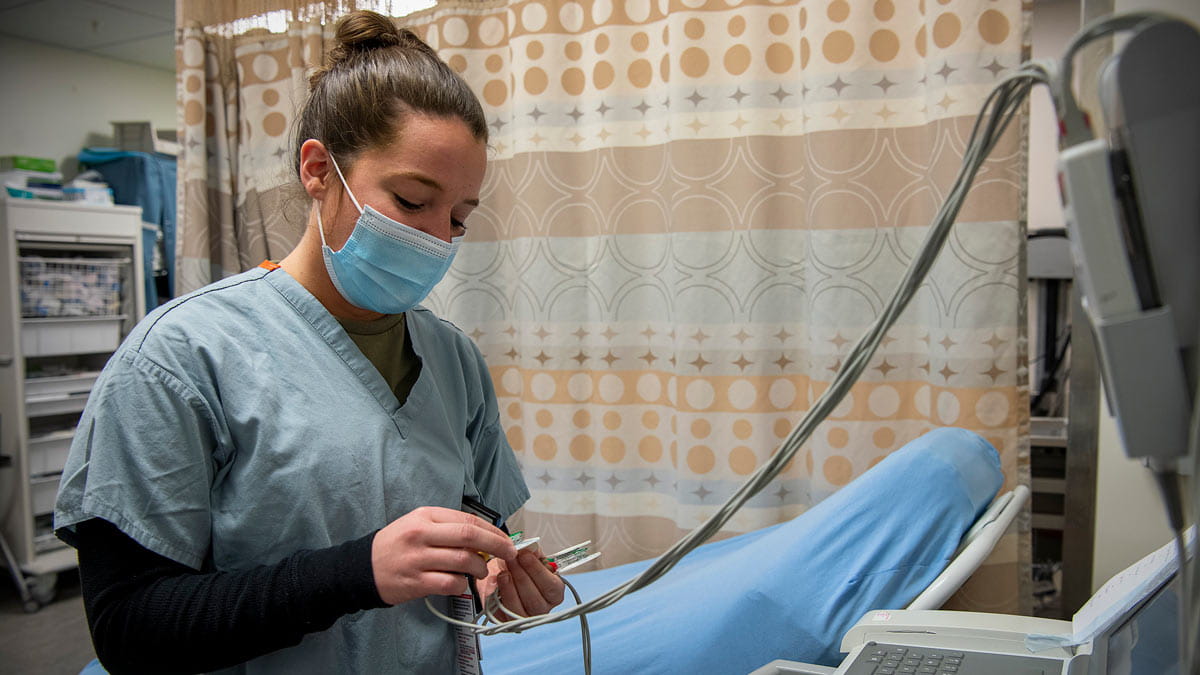Collaborative Cross mice used in genetics research to study post-traumatic epilepsy

Post-traumatic epilepsy (PTE) is a critical condition that commonly occurs after a traumatic brain injury. It’s characterized by spontaneous recurrent seizures that can occur weeks to years after the initial head trauma. PTE can usher in other complications, such as changes in behavior, mood and sleep. It’s also associated with an increased risk for death. However, the causes of PTE and other complications following a traumatic brain injury aren't clearly identified, yet they are commonly seen in military and veteran communities.
Bin Gu, PhD, assistant professor in the Department of Neuroscience at The Ohio State University College of Medicine, is researching the genetic and pathophysiologic foundation of PTE. When asked how his research impacts the military and veteran communities, he references two studies that show military personnel had a total incidence of post-traumatic seizures ranging from 33% to 55%, which is a clinically significant risk. Gu further emphasizes the impact of this neurologic disorder on all aspects of an individual’s life.
“PTE affects all aspects of an individual’s life, placing a considerable economic and social burden on military service members, veterans and their families,” Gu says.
Gu, in collaboration with Olga Kokiko-Cochran, PhD, assistant professor in the Department of Neuroscience at the Ohio State College of Medicine, and Fernando Pardo Manuel de Villena, PhD, professor and chair of the Department of Genetics at the University of North Carolina, Chapel Hill, are using an interdisciplinary approach to study PTE and the varying complications following a traumatic brain injury. Their ultimate goal is to improve the prevention measures and treatment options for PTE.
Current research indicates that this neurological disorder is influenced by predisposing genetic traits. Gu and his team are utilizing a novel research approach to examine the genetic susceptibility for PTE and it involves Collaborative Cross mice.
This breed of mice offers much more genetic diversity than the typical inbred mice used in research. In addition, Collaborative Cross mice offer three times the amount of genetic variance that is seen in humans. The mirrored genetic diversity between humans and Collaborative Cross mice allows for a better translation of preclinical research.
The Gu Lab was provided $755,250 in funding from the U.S. Department of Defense’s Congressionally Directed Medical Research Program. This funding will support Gu and his research team from September 2022 until 2025 as they work to identify the pathologic markers and causes of PTE.
Gu and his research team are working to define extreme post-traumatic epilepsy responses and identify critical genetic factors. These genetic factors directly influence the susceptibility to and resiliency against developing this neurological disorder.
To do this, Collaborative Cross mice are monitored using chronic video-EEG recording devices following a traumatic brain injury. However, Gu notes the difficulties in this procedure by saying that “the rare and unpredictable nature of spontaneous seizures makes this process time-consuming and technically challenging.”
However, this close examination enables Gu and his team to examine the interplay between PTE and other complications following a traumatic brain injury: behavioral deficits, EEG abnormalities, sleep disturbances, neuroinflammation and hippocampal sclerosis. The goal is to identify the specific mice with extreme PTE responses and establish a repository of biospecimens for future use in research.
In addition to understanding how PTE plays out in Collaborative Cross mice, Gu is studying their genetic variations in a controlled environment to locate and identify the genes responsible for PTE risk and resiliency.
A key part of this effort involves the unique experimental approaches this research team is using. Once PTE is identified in a strain of mice, quantitative trait locus (QTL) mapping is used to explore the specific locations within the mouse genome that control the presentation of the neurological disorder.
Bin Gu, PhD, assistant professor in the Department of Neuroscience at The Ohio State University College of Medicine, is researching the genetic and pathophysiologic foundation of PTE. When asked how his research impacts the military and veteran communities, he references two studies that show military personnel had a total incidence of post-traumatic seizures ranging from 33% to 55%, which is a clinically significant risk. Gu further emphasizes the impact of this neurologic disorder on all aspects of an individual’s life.
“PTE affects all aspects of an individual’s life, placing a considerable economic and social burden on military service members, veterans and their families,” Gu says.
Gu, in collaboration with Olga Kokiko-Cochran, PhD, assistant professor in the Department of Neuroscience at the Ohio State College of Medicine, and Fernando Pardo Manuel de Villena, PhD, professor and chair of the Department of Genetics at the University of North Carolina, Chapel Hill, are using an interdisciplinary approach to study PTE and the varying complications following a traumatic brain injury. Their ultimate goal is to improve the prevention measures and treatment options for PTE.
Current research indicates that this neurological disorder is influenced by predisposing genetic traits. Gu and his team are utilizing a novel research approach to examine the genetic susceptibility for PTE and it involves Collaborative Cross mice.
This breed of mice offers much more genetic diversity than the typical inbred mice used in research. In addition, Collaborative Cross mice offer three times the amount of genetic variance that is seen in humans. The mirrored genetic diversity between humans and Collaborative Cross mice allows for a better translation of preclinical research.
The Gu Lab was provided $755,250 in funding from the U.S. Department of Defense’s Congressionally Directed Medical Research Program. This funding will support Gu and his research team from September 2022 until 2025 as they work to identify the pathologic markers and causes of PTE.
Gu and his research team are working to define extreme post-traumatic epilepsy responses and identify critical genetic factors. These genetic factors directly influence the susceptibility to and resiliency against developing this neurological disorder.
To do this, Collaborative Cross mice are monitored using chronic video-EEG recording devices following a traumatic brain injury. However, Gu notes the difficulties in this procedure by saying that “the rare and unpredictable nature of spontaneous seizures makes this process time-consuming and technically challenging.”
However, this close examination enables Gu and his team to examine the interplay between PTE and other complications following a traumatic brain injury: behavioral deficits, EEG abnormalities, sleep disturbances, neuroinflammation and hippocampal sclerosis. The goal is to identify the specific mice with extreme PTE responses and establish a repository of biospecimens for future use in research.
In addition to understanding how PTE plays out in Collaborative Cross mice, Gu is studying their genetic variations in a controlled environment to locate and identify the genes responsible for PTE risk and resiliency.
A key part of this effort involves the unique experimental approaches this research team is using. Once PTE is identified in a strain of mice, quantitative trait locus (QTL) mapping is used to explore the specific locations within the mouse genome that control the presentation of the neurological disorder.
Gu acknowledges that identifying the location of susceptible genes is paramount to helping us better understand which individuals with a traumatic brain injury are at higher risk for posttraumatic epilepsy. “Identifying these molecular mechanisms will lead to improved patient care,” Gu says. “We are dedicated to seeking better preventive and treatment methods for the seizures and their related neurologic and psychiatric complications after a traumatic brain injury.”



